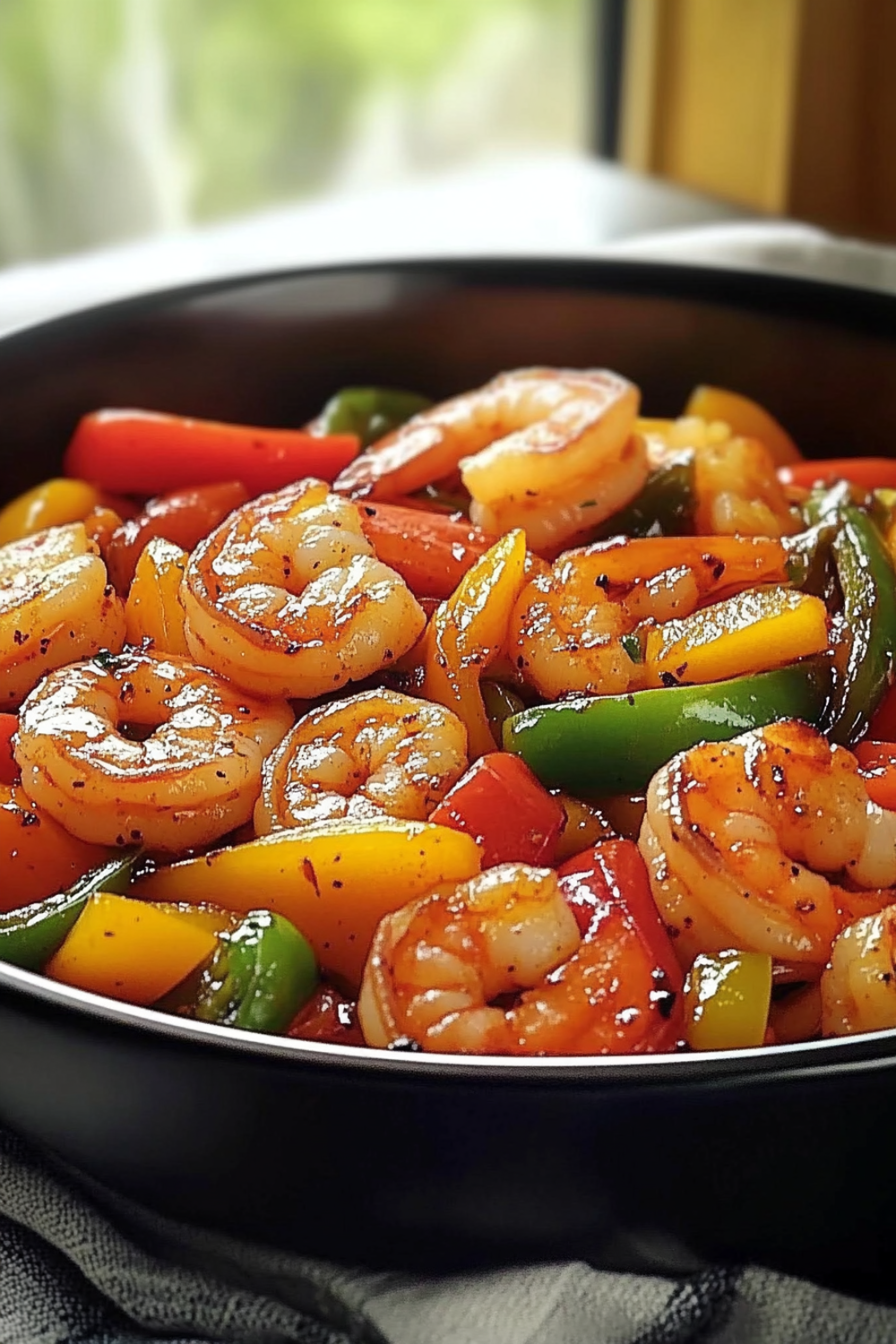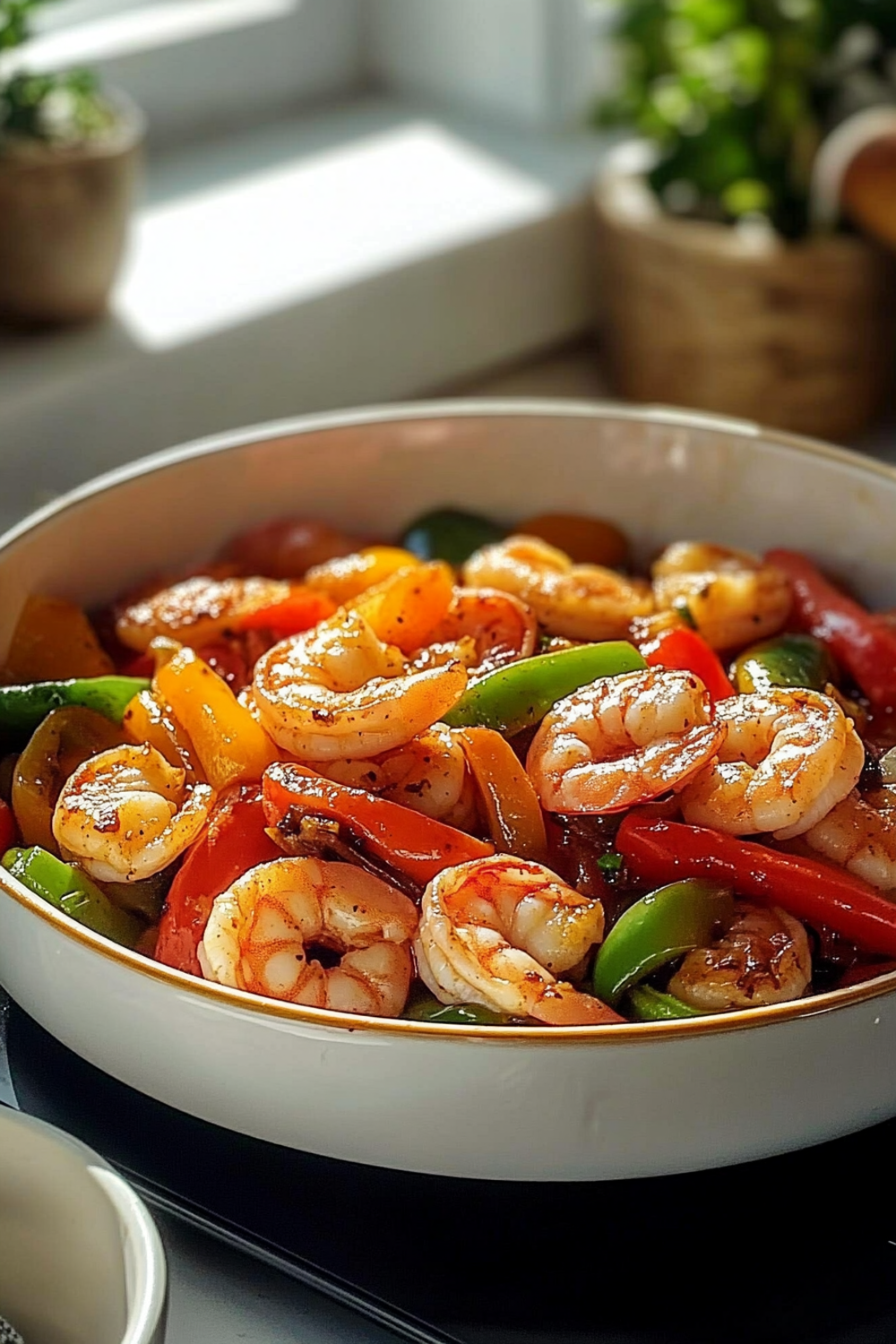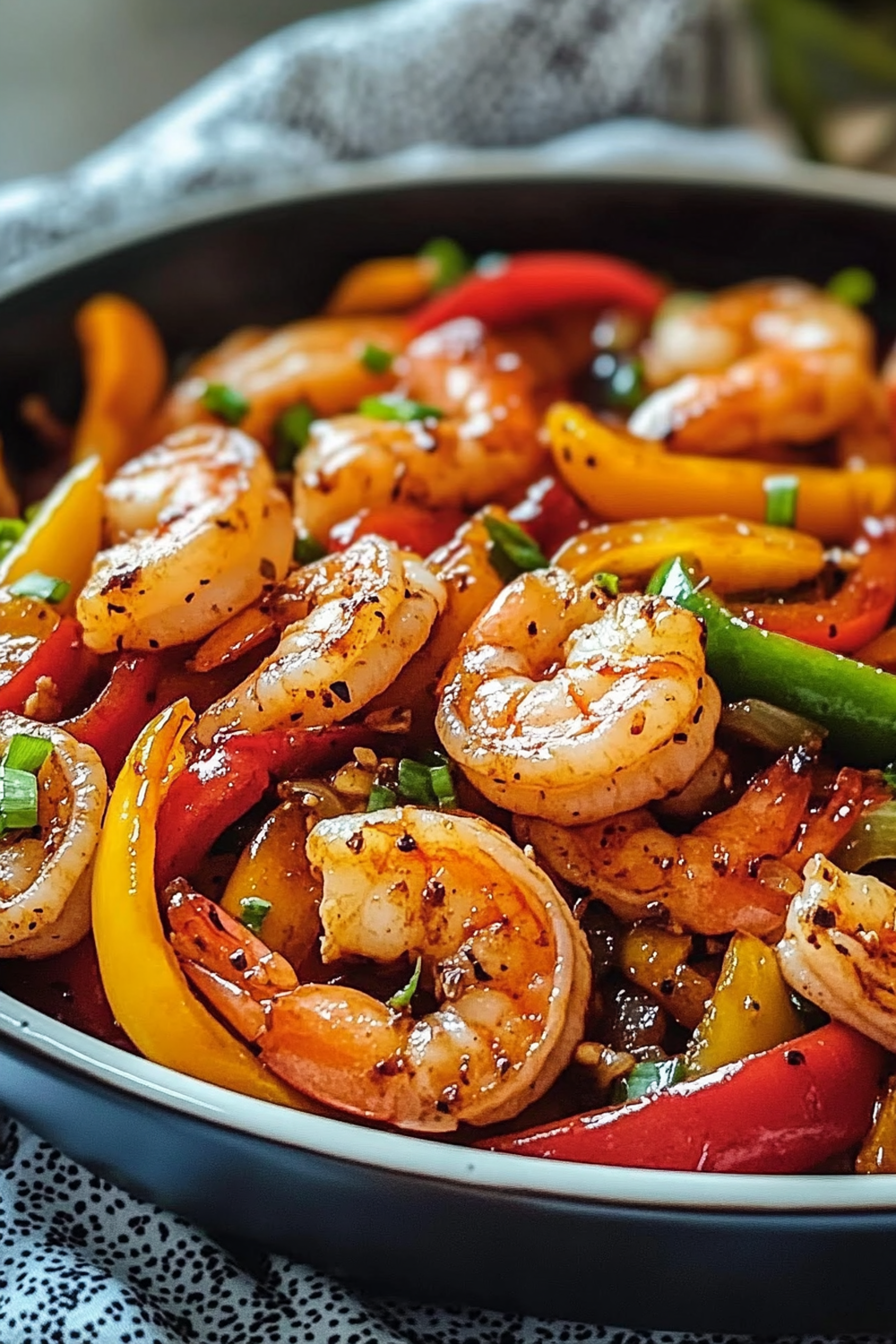Shrimp and Pepper Stir-Fry is not just a meal; it’s an experience filled with vibrant colors and delightful flavors that excite the palate. This dish combines succulent shrimp with crisp bell peppers, creating a harmony of textures that is as pleasing to the eye as it is to the taste buds. In less than 30 minutes, you can whip up this restaurant-quality dish at home, making it an ideal choice for busy weeknights or last-minute dinner parties.

The beauty of this Shrimp and Pepper Stir-Fry lies in its simplicity. With a handful of fresh ingredients and a few pantry staples, you can create a healthy meal that doesn’t compromise on taste. The combination of shrimp, peppers, garlic, soy sauce, and spices results in a dish that is both savory and satisfying. Plus, it’s easily customizable—feel free to throw in your favorite vegetables or adjust the spice level to suit your taste.
Whether you serve it over steamed rice or enjoy it on its own as a low-carb option, this stir-fry will surely become a family favorite. So grab your wok or skillet, and let’s dive into this delicious recipe that will make your dinner time both exciting and nutritious.
Main Ingredients
Shrimp (1 pound)
Fresh or frozen shrimp forms the backbone of this dish. When selecting shrimp for your stir-fry, opt for medium to large-sized varieties for the best texture. If using frozen shrimp, ensure they are thawed before cooking to achieve even cooking results. Shrimp are not only flavorful but also packed with protein and omega-3 fatty acids, making them a healthy addition to any meal.
Bell Peppers (2 cups)
Using bell peppers adds both color and crunch to your stir-fry. For this recipe, choose a mix of red, yellow, and green peppers to create visual appeal. Slice them into thin strips so they cook evenly alongside the shrimp. These vibrant vegetables provide essential vitamins like C and A while adding sweetness that complements the savory elements of the dish.
Garlic (4 cloves)
Garlic is essential for enhancing the flavor profile of your Shrimp and Pepper Stir-Fry. Minced garlic releases an aromatic essence that deepens the overall taste of your meal. When sautéed until golden brown, garlic adds warmth without overpowering other ingredients. It also offers numerous health benefits, including anti-inflammatory properties.
Soy Sauce (3 tablespoons)
Soy sauce brings depth and umami flavor to your stir-fry. Use low-sodium soy sauce if you’re watching your salt intake; it still delivers that rich flavor without being too salty. The dark color of soy sauce enhances the appearance of your dish while contributing necessary moisture during cooking.
Olive Oil (2 tablespoons)
For cooking your stir-fry, olive oil is an excellent choice due to its high smoke point and heart-healthy fats. It allows for even heat distribution while preventing sticking in your pan or wok. Feel free to substitute with sesame oil for added flavor if desired; however, be cautious as sesame oil has a lower smoke point.

How to Prepare Shrimp and Pepper Stir-Fry
Step 1: Prepare Your Ingredients
Start by rinsing the shrimp under cold water if they are frozen; then pat them dry using paper towels to remove excess moisture. This step ensures they sear properly rather than steam when placed in the hot pan. Next, wash the bell peppers thoroughly before cutting them into thin strips—this allows them to cook quickly while maintaining their crispness during stir-frying.
Once you’ve prepared the vegetables and seafood, mince four cloves of garlic finely so they can infuse their flavor throughout the dish seamlessly. Gather all ingredients close by so you can work efficiently without interruption as stir-frying requires quick movements.
Step 2: Heat Your Pan
Place your skillet or wok over medium-high heat until it becomes hot enough for frying—this usually takes about 3 minutes depending on your stove’s power level. Add two tablespoons of olive oil into the pan; ensure it’s evenly distributed across its surface before adding any ingredients.
You’ll know when it’s ready when small ripples form on top of the oil without smoking excessively—a sign you’re set to add those flavorful morsels! This step ensures that everything cooks evenly while developing those sought-after crispy edges on both shrimp and vegetables.
Step 3: Cook The Shrimp
Carefully place all prepared shrimp into the hot pan in one single layer; avoid crowding them as this can lead to steaming instead of frying! Allow them time—about two minutes—before flipping each piece over using tongs or a spatula.
As they cook through completely (approximately another minute), you’ll notice their color changes from grayish-blue to opaque pink—this indicates doneness! Once cooked perfectly yet still tender inside (not rubbery), remove them from heat onto a plate temporarily while continuing with vegetables.
Step 4: Sauté The Vegetables
Incorporate bell pepper strips directly into that sizzling hot skillet left behind from cooking those lovely shrimps! Sauté these colorful veggies until softened slightly but remaining crunchy—usually around three minutes should suffice here!
Adding minced garlic after about one minute helps prevent burning; remember it cooks faster than other components! Keep stirring occasionally ensuring even exposure throughout cooking time until fragrant aromas fill your kitchen air!
Once done sautéing those veggies nicely together with garlic infusion complete (and tasting delicious), return those cooked succulent shrimps back into pan mixing everything well before pouring three tablespoons soy sauce over desired mix!
Step 5: Final Touches
At this stage feel free adjusting seasoning according personal preference! You might want more soy sauce for saltiness balance depending upon individual tastes preferences! Mix everything thoroughly ensuring each bite receives equal amounts flavorfulness!
Letting mixture simmer gently helps meld various flavors together beautifully—allowing roughly one minute before removing from heat keeps freshness intact without overcooking either ingredient present within dish itself simply perfection achieved here!

Serving and Storing Tips
Serving Suggestions
For serving size recommendations consider offering approximately one cup per person as part main course served alongside steamed rice or quinoa providing additional sustenance filling options available alongside fresh vegetables already integrated within meal itself guaranteeing satisfaction across board diners alike!
Alternatively serve smaller portions atop lettuce leaves creating delightful wraps showcasing bright colors appealing visually enhancing overall presentation potential too enticing guests further encouraging enjoyment overall dining experience shared among friends family alike!
Don’t forget garnishing options available such chopped scallions cilantro lime wedges sprinkled atop dishes presenting finishing touches elevating aesthetics significantly along providing extra layers flavor enhancement enjoyed throughout meal journey begin here today!
Storing Leftovers
If there happen remain any leftovers after indulgent feast don’t worry simply store remaining portions airtight container refrigerating promptly consuming within three days maximum safely enjoying flavors day two three without compromising quality enjoyed first night prepared fresh evening prior sharing good news now everyone loves leftovers especially ones involving delicious combinations featured prominently throughout recipe presented today!
Reheating leftover creations can done easily either microwave stovetop bring back initial warmth restoring enjoyment moments experienced during initial mealtime gathering great memories relived once again through delightful bites shared together effortlessly through culinary adventures embarked upon successfully showcasing talents highlighted initially beginning right now making every moment count fully experiencing all wonders offered here today!
Mistakes to avoid
One common mistake when preparing shrimp and pepper stir-fry is overcooking the shrimp. When shrimp cooks too long, it becomes tough and rubbery, losing its delicate flavor and texture. To avoid this, ensure you cook the shrimp just until they turn pink and opaque. This usually takes about 2-3 minutes on high heat, depending on their size. Always remove them from the pan as soon as they’re done to prevent carryover cooking.
Another frequent error is neglecting to prep your ingredients beforehand. Stir-frying requires quick cooking times, so having all your vegetables sliced and sauces measured out before you start cooking is essential. This preparation helps maintain a smooth flow in the kitchen, ensuring everything cooks evenly without burning while you’re busy chopping.
Additionally, using the wrong type of oil can ruin your dish. Oils with low smoke points, such as olive oil, may burn quickly at high temperatures needed for stir-frying. Instead, opt for oils like vegetable or peanut oil that can withstand higher heat. This choice will help achieve that perfect sizzle and sear on your shrimp and peppers.
Lastly, overcrowding the pan is a common pitfall. Adding too much food at once lowers the temperature of the pan, causing steaming rather than frying. You’ll want to cook in batches if necessary to maintain high heat. This practice ensures each ingredient gets that beautiful char which enhances flavors significantly.

Tips and tricks
To elevate your shrimp and pepper stir-fry experience, consider marinating your shrimp beforehand. A simple marinade made from soy sauce, garlic, and ginger adds depth of flavor that penetrates the shrimp beautifully. Marinate for at least 15 minutes but no more than 30 minutes to avoid a mushy texture from overly acidic ingredients.
Another tip is to use fresh vegetables for vibrant color and nutrition in your dish. Bell peppers are a fantastic choice due to their sweetness and crunchiness when cooked quickly over high heat. Utilize a mix of colors—red, yellow, and green—to create an appealing visual contrast that draws everyone’s attention.
Temperature control plays a crucial role in achieving the perfect stir-fry. Ensure your wok or skillet is hot enough before adding any ingredients; this quick searing locks in moisture while creating those delicious browned bits at the bottom of the pan known as “fond.” If you’re unsure about temperature readiness, sprinkle a few drops of water into the pan; if they dance around and evaporate immediately, you’re good to go!
Don’t forget about garnishing! A sprinkle of sesame seeds or chopped green onions adds not only flavor but also visual appeal to your dish. You can also add a squeeze of lime juice right before serving for an extra burst of freshness that complements the shrimp wonderfully.
Suggestions for Shrimp and Pepper Stir-Fry
When making shrimp and pepper stir-fry, consider different types of peppers for varied flavors. While bell peppers are classic choices, experimenting with spicy jalapeños or sweet mini peppers can introduce exciting new tastes to your dish. Each pepper variety brings unique characteristics that enhance overall complexity.
Adding aromatics like garlic and ginger boosts both flavor and aroma significantly. Sauté these ingredients briefly before introducing the shrimp to infuse their essence throughout the dish effectively. Their pungent qualities balance well with the sweetness of bell peppers while elevating your meal’s overall profile.
For additional texture, incorporate crunchy elements such as water chestnuts or snap peas into your stir-fry mix. These ingredients not only provide a satisfying crunch but also add nutritional value without overwhelming other flavors present in your dish.
Using homemade sauces allows you full control over flavor profiles in your stir-fry creations. Simple mixtures combining soy sauce with oyster sauce or hoisin sauce create rich backgrounds for your meal while customizing sweetness levels according to personal preferences.

FAQs
What type of shrimp should I use for Shrimp and Pepper Stir-Fry?
The best type of shrimp for this recipe includes medium or large-sized varieties such as Gulf or Tiger shrimp due to their firm texture that holds up well during cooking. Always select fresh or frozen raw shrimp without shells for convenience; pre-cooked varieties may not yield desirable results since they risk becoming overcooked during preparation.
Can I use frozen shrimp directly in my Shrimp and Pepper Stir-Fry?
Yes! Frozen shrimp can be used directly; however, it’s crucial first to thaw them properly by placing them under cold running water or leaving them overnight in the refrigerator before use. Cooking frozen shrimp straight from their packaging might lead to uneven cooking since some pieces may still be icy while others could become overdone.
How do I know when my shrimp are fully cooked?
You’ll know your shrimp are fully cooked when they turn pink with opaque centers instead of translucent ones—this usually takes 2-3 minutes on high heat depending on size! Additionally, perfectly cooked shrimp curl into a C shape rather than forming an O shape indicative of overcooking.
Is it necessary to marinate my shrimp before cooking?
While marinating isn’t strictly necessary for delicious results in Shrimp and Pepper Stir-Fry recipes—it does enhance flavors immensely! A brief marinade (15-30 minutes) introduces additional seasoning while keeping shrimps tender—just avoid prolonged marination times as acidity could lead them towards mushiness!
Can I add other vegetables to my Shrimp and Pepper Stir-Fry?
Absolutely! Feel free to add any preferred seasonal veggies like broccoli florets or carrots alongside bell peppers! Just remember that different vegetables have various cooking times; thus introducing denser ones earlier will yield balanced textures across all ingredients when served!
How can I store leftover Shrimp and Pepper Stir-Fry?
Leftover Shrimp & Pepper Stir-Fry should be stored promptly after cooling down—seal tightly within an airtight container stored in either fridge (for up-to three days) or freezer (for up-to three months). Reheat thoroughly before serving again ensuring food safety guidelines remain intact throughout storage duration!


1 thought on “Quick and Easy Shrimp and Pepper Stir-Fry Recipe”